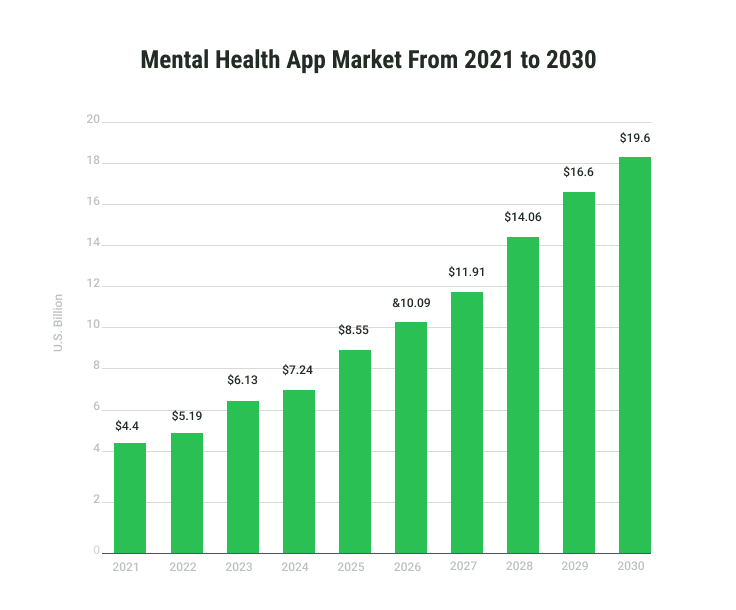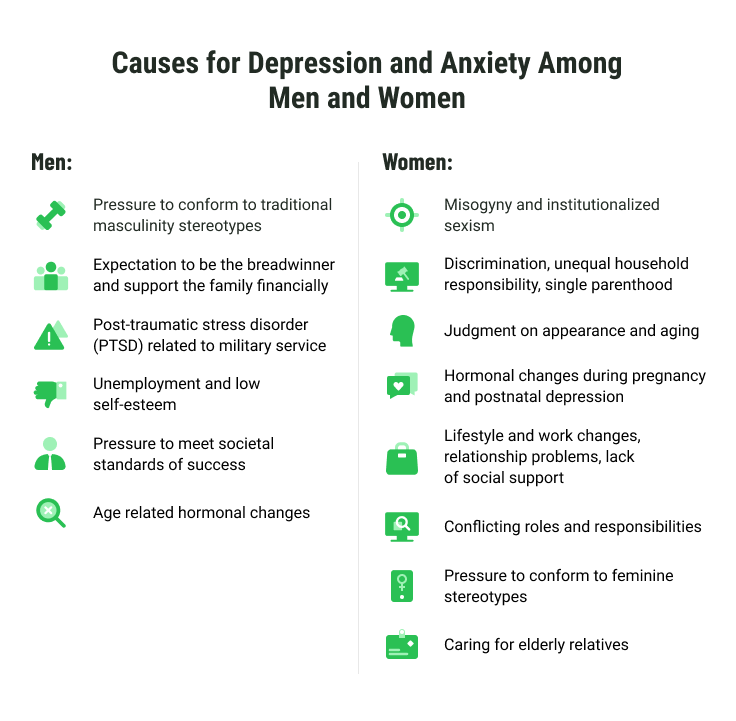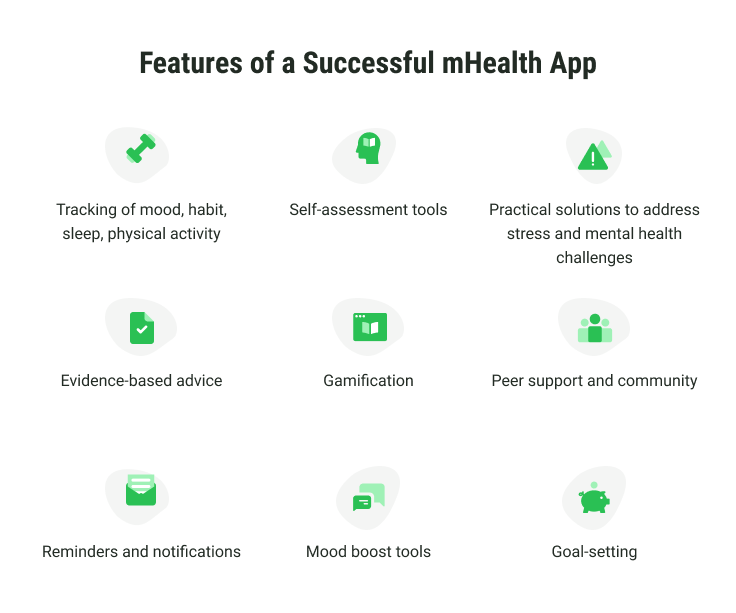Wellness and Mental Health Apps for Men
Table of contents
- Do Men Need Any Mental or Wellness Health Apps?
- Men’s Health Apps: the Market Overview
- How to Develop a Mental/Wellness App for Males?
- Stage 1. User research and planning
- Stage 2. Design and development
- Stage 3. Testing and deployment
- What Features to Add to Your Mental App for Men?
- Focus on functionality
- Avoid hypermasculine stereotypes
- Incorporate gamification elements
- Provide personalized experiences
- Highlight the benefits
- Bottom Line
In the realm of health apps, a noticeable discrepancy exists between offerings tailored to women and those available for men. While there is an array of female-focused health apps covering various aspects of well-being, the same cannot be said for men, particularly in the wellness and mental health domain. This fact raises a critical question: Why do men need a mental health app designed specifically for them?
In this article, we will explore the reasons behind the necessity of a dedicated men’s mental health app, how to create a mental health app, discuss how such an app could differ from those designed for women, and explore the essential features that should be included to ensure it meets the needs of male users.
Do Men Need Any Mental or Wellness Health Apps?
With an increased focus on improving access to mental health services and reducing financial barriers that often prevent individuals from seeking help, mental health aid has become more affordable and hence, widespread. At the same time, there is a significant disparity in the percentage of men and women receiving psychological assistance, with women being the most clients attending therapy.
Does it mean women are more likely to be depressed? Not exactly: although studies show mixed results, some observations claim that men and women experience depression at similar rates. However, the suicide rate among men has been about 4 times higher than that of women for over the past couple of decades. The thing is, men are less likely to seek psychological help.
There is a variety of reasons for this:
- A stigma ingrained by prevailing cultural masculine norms discourages men from expressing emotions and seeking help
- Cultural norms with an emphasis on self-reliance
- Reluctance to admit or acknowledge the need for help due to concerns about the perceived loss of control
- Underestimating the severity or impact of mental health issues
- Misperceptions that mental health support is primarily for women and not relevant to men's experiences
- Limited access to mental health services, including financial barriers or lack of nearby providers.

The lack of dedicated resources highlights the need for specialized mental health apps tailored to males’ unique experiences. By breaking the stigma, addressing barriers, and providing accessible support, these apps can serve as valuable tools in promoting well-being and supporting individuals until they can receive the necessary professional help they may require.
Men’s Health Apps: the Market Overview
The global market for mental health apps was valued at USD 4.4 billion in 2021 and is projected to reach approximately USD 19.6 billion by 2030, growing at a compound annual growth rate (CAGR) of 18.06% from 2022 to 2030. The market is witnessing a rise in the number of mental health apps; however, the majority of these apps are not gender-specific and are designed to cater to all segments of users.

Some people argue that men and women experience different mental health challenges and, therefore, require different apps to effectively address these challenges.

Although the causes for depression, such as biological, environmental, psychological, social factors, and hormonal changes, can be similar for both men and women, many apps in the market lack comprehensive support and tend to provide generalized assistance for conditions like anxiety or eating disorders, without addressing the underlying root causes effectively.
Overall, men may face unique mental health challenges and societal pressures that can differ from those experienced by women. And all of them can be addressed more effectively in a dedicated app.
How to Develop a Mental/Wellness App for Males?
Once the need for a unique mental health app for men has been identified, the next step is to explore the process of developing and designing such an application.
Stage 1. User research and planning
Prior to embarking on the development of an application, a thorough market and target audience analysis is essential. Companies should assess existing applications, identify their unique value propositions, and pinpoint any drawbacks that their own application can address.
A study conducted by Australian researchers to find out what young people expect from a mental health app highlights the three key considerations in the development of a mental health app based on participant feedback:
- Privacy. Those surveyed indicated anonymity in a mental health app as a major concern. Users expressed the importance of clear communication about data usage and the need for confidentiality. Balancing the communication of anonymity while not overwhelming the user was deemed crucial.
- User empowerment. Participants emphasized the importance of retaining choice and control over help-seeking behaviors. Notifications were suggested to be gentle and sensitive, allowing users to make their own decisions about accessing support. Customizability, both in terms of preferences and app notifications, was highly valued by participants.
- Engagement and achievement was a topic of mixed opinions. While some participants liked the idea of incentives or rewards, many saw them as too goal-oriented for a mental health app. Some preferred small encouragements or aesthetic rewards, while others felt that increased skill in mood management would be rewarding enough.
Before proceeding with the development process, it is crucial to carefully consider the results and incorporate them into the concept of the final product.
Stage 2. Design and development
Following the design and development stages, begin by creating wireframes, mockups, and prototypes to visualize the app's UI and UX. This step allows you to test the app's functionality and usability. Next, proceed to write code for the front-end and back-end, integrate required third-party APIs, and conduct comprehensive testing to identify and resolve any bugs or errors.
A recommended approach is to start by developing a Minimum Viable Product (MVP) that includes only the core features. By releasing the MVP, you can test the concept, gather valuable feedback from users, and identify any vulnerabilities. Based on this feedback, you can then incorporate additional features and improvements to enhance the app's functionality and user experience.
Stage 3. Testing and deployment
Once the app is developed, the next crucial step is testing to ensure its functionality and the ability to meet user requirements. This involves conducting alpha testing and beta testing to identify and address any issues. The app is then ready for release to the public. This involves activities such as app store submission, marketing, promotion, and, finally, the official launch.
Following the release, ongoing maintenance and support are essential. This includes addressing bug fixes, implementing updates, and providing customer support. Additionally, monitoring app usage and analyzing data analytics help identify areas for improvement and optimizing the app's performance.
What Features to Add to Your Mental App for Men?
As we have figured out that the causes for seeking psychological assistance for men and women differ, the app can therefore differ as well. Let’s discover how to design an app for the unique needs of males based on research on how young men and women differ in well-being app usage.

Focus on functionality
The research shows that males tend to be more concerned with the actual functionality of apps in contrast to women. For example, the majority of the men surveyed hardly remembered the name of the app, being more focused on specific goals and features, like tracking, while females mentioned specific app usage and named the apps.
Avoid hypermasculine stereotypes
While designing for males, it is essential to steer clear of reinforcing hypermasculine stereotypes. Create an inclusive environment that promotes well-being without perpetuating certain expectations.
Incorporate gamification elements
Studies show that gaming features can increase engagement. Explore how gamification techniques can be integrated into the app's design to make it more interactive and enjoyable for male users. However, it’s important not to overly focus on competition or aggressive gameplay.
Provide personalized experiences
Consider implementing personalized features that allow users to customize their app experience according to their preferences. This can include customization of notifications, preferences, and content to enhance engagement and satisfaction.
Highlight the benefits
Clearly communicate the benefits of using the app in a way that resonates with male users. Emphasize the positive impact on well-being, stress management, and personal growth. Providing psycho-education within the app can help users understand the significance of well-being at a personal level.
It's also crucial to identify the unique features to include in an app tailored for men's mental well-being.

During the research study, Worker Preferences for a Mental Health App Within Male-Dominated Industries, several key findings emerged regarding the design and features of a mental health app for men. For example, they emphasized the importance of minimal text reading and visual content. Also, they indicated that restructuring longer therapeutic interventions into shorter, daily challenges would better align with their preferences for concise and interactive content.
Bottom Line
The approach to developing a mental health app for men depends on various factors. One option is to choose a narrow wellness/mental health niche, such as developing an app specifically for coping with PTSD. This allows for a comprehensive solution with a focus on specific scientific approaches. Another option is to create a super app that covers a wide range of topics and functions as a comprehensive well-being tool.
No matter which approach you choose for developing a mental health app, having a trusted development partner is crucial. That's where Emerline comes in. As a software development company with extensive experience across various industries, we have successfully delivered numerous projects, including those in the health and wellness sector.
We understand the importance of creating tailored solutions that meet the unique needs of our clients. If you're looking to develop a mental health app, book a free consultation with our experts. Together, we can bring your vision to life and create a powerful and impactful app that makes a difference in the lives of its users.
Published on Jul 4, 2023





